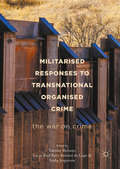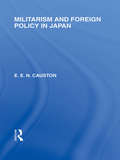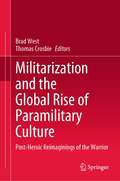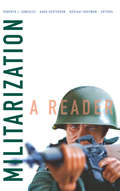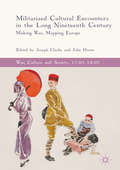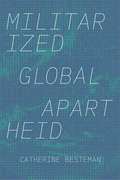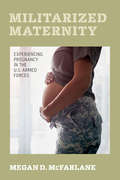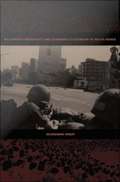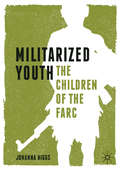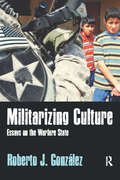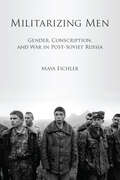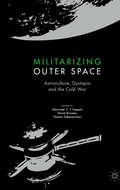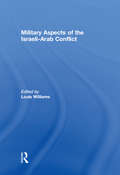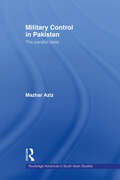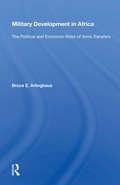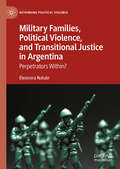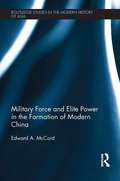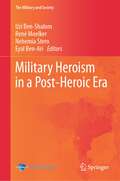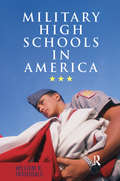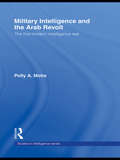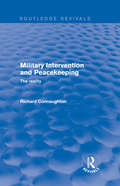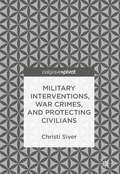- Table View
- List View
Militarised Responses to Transnational Organised Crime
by Sasha Jesperson Tuesday Reitano Lucia Bird Ruiz-Benitez de LugoThis edited volume examines the use of militarised responses to different forms of criminal activity, discussing the outcomes and unintended consequences. Politicians and policymakers frequently use militarised responses to look tough on crime. The deployment of armies, navies, military assets and militarised approaches can send a powerful message, but have produced mixed results. While they generate the perception that governments are actively engaged on issues of concern to the public, and in some cases have resulted in notable successes, on the downside they have frequently also increased the loss of life, exacerbated the humanitarian consequences of a particular crime and entrenched divides between security and state institutions and the criminal proponents, narrowing the possibilities for future negotiated solutions. By focusing on four different areas of criminality - wildlife crime, piracy, migration and drug trafficking - the book allows context and evidence-based conclusions to be drawn on the strategic value and commonality of responses and their outcomes.
Militarism and Foreign Policy in Japan (Routledge Library Editions: Japan)
by E E CaustonThe Manchurian "Incident" of 1931 led to a Japanese occupation, the birth of Manchoukuo and the withdrawal of Japan from the League of Nations. At the time it seemed as if the army and navy were exerting a supreme influence. This volume points out that this influence is not new and that there are strong reasons for its existence and continuance. It shows how it is fostered by the peculiar political structure of the country, and how, though often unintelligible to Europeans, it may be understood and accounted for in the light of the historical and political background of Japan.
Militarization and the Global Rise of Paramilitary Culture: Post-Heroic Reimaginings of the Warrior
by Brad West Thomas CrosbieThis edited book demonstrates a new multidimensional comprehension of the relationship between war, the military and civil society by exploring the global rise of paramilitary culture. Moving beyond binary understandings that inform the militarization of culture thesis and examining various national and cultural contexts, the collection outlines ways in which a process of paramilitarization is shaping the world through the promotion of new warrior archetypes. It is argued that while the paramilitary hero is associated with military themes, their character is in tension with the central principals of modern military organization, something that often challenges the state’s perceived monopoly on violence. As such paramilitization has profound implications for institutional military identity, the influence of paramilitary organizations and broadly how organised violence is popularly understood
Militarization: A Reader (Global Insecurities)
by Roberto J. GonzálezMilitarization: A Reader offers a range of critical perspectives on the dynamics of militarization as a social, economic, political, cultural, and environmental phenomenon. It portrays militarism as the condition in which military values and frameworks come to dominate state structures and public culture both in foreign relations and in the domestic sphere. Featuring short, readable essays by anthropologists, historians, political scientists, cultural theorists, and media commentators, the Reader probes militarism's ideologies, including those that valorize warriors, armed conflict, and weaponry. Outlining contemporary militarization processes at work around the world, the Reader offers a wide-ranging examination of a phenomenon that touches the lives of billions of people. In collaboration with Catherine Besteman, Andrew Bickford, Catherine Lutz, Katherine T. McCaffrey, Austin Miller, David H. Price, David Vine
Militarized Cultural Encounters in the Long Nineteenth Century: Making War, Mapping Europe (War, Culture and Society, 1750-1850)
by John Horne Joseph ClarkeThis book explores European soldiers’ encounters with their continent’s exotic frontiers from the French Revolution to the First World War. In numerous military expeditions to Italy, Spain, Russia, Greece and the ‘Levant’ they found wild landscapes and strange societies inhabited by peoples who needed to be ‘civilized.’ Yet often they also discovered founding sites of Europe’s own ‘civilization’ (Rome, Jerusalem) or decaying reminders of ancient grandeur. The resulting encounters proved seminal in forging a military version of the ‘civilizing mission’ that shaped Europe’s image of itself as well as its relations with its own periphery during the long nineteenth century.
Militarized Global Apartheid (Global Insecurities)
by Catherine BestemanIn Militarized Global Apartheid Catherine Besteman offers a sweeping theorization of the ways in which countries from the global north are reproducing South Africa's apartheid system on a worldwide scale to control the mobility and labor of people from the global south. Exploring the different manifestations of global apartheid, Besteman traces how militarization and securitization reconfigure older forms of white supremacy and deploy them in new contexts to maintain this racialized global order. Whether using the language of security, military intervention, surveillance technologies, or detention centers and other forms of incarceration, these projects reinforce and consolidate the global north's political and economic interests at the expense of the poor, migrants, refugees, Indigenous populations, and people of color. By drawing out how this new form of apartheid functions and pointing to areas of resistance, Besteman opens up new space to theorize potential sources of liberatory politics.
Militarized Maternity: Experiencing Pregnancy in the U.S. Armed Forces
by Megan D. McFarlaneThe rights of pregnant workers as well as (the lack of) paid maternity leave have increasingly become topics of a major policy debate in the United States. Yet, few discussions have focused on the U.S. military, where many of the latest policy changes focus on these very issues. Despite the armed forces' increases to maternity-related benefits, servicewomen continue to be stigmatized for being pregnant and taking advantage of maternity policies. In an effort to understand this disconnect, Megan McFarlane analyzes military documents and conducts interviews with enlisted servicewomen and female officers. She finds a policy/culture disparity within the military that pregnant servicewomen themselves often co-construct, making the policy changes significantly less effective. McFarlane ends by offering suggestions for how these policy changes can have more impact and how they could potentially serve as an example for the broader societal debate.
Militarized Modernity and Gendered Citizenship in South Korea
by Seungsook MoonThis pathbreaking study presents a feminist analysis of the politics of membership in the South Korean nation over the past four decades. Seungsook Moon examines the ambitious effort by which South Korea transformed itself into a modern industrial and militarized nation. She demonstrates that the pursuit of modernity in South Korea involved the construction of the anticommunist national identity and a massive effort to mold the populace into useful, docile members of the state. This process, which she terms "militarized modernity," treated men and women differently. Men were mobilized for mandatory military service and then, as conscripts, utilized as workers and researchers in the industrializing economy. Women were consigned to lesser factory jobs, and their roles as members of the modern nation were defined largely in terms of biological reproduction and household management. Moon situates militarized modernity in the historical context of colonialism and nationalism in the twentieth century. She follows the course of militarized modernity in South Korea from its development in the early 1960s through its peak in the 1970s and its decline after rule by military dictatorship ceased in 1987. She highlights the crucial role of the Cold War in South Korea's militarization and the continuities in the disciplinary tactics used by the Japanese colonial rulers and the postcolonial military regimes. Moon reveals how, in the years since 1987, various social movements--particularly the women's and labor movements--began the still-ongoing process of revitalizing South Korean civil society and forging citizenship as a new form of membership in the democratizing nation.
Militarized Youth: The Children of the FARC
by Johanna HiggsBased on ethnographic fieldwork and interviews from across Colombia—including former child guerillas, former hostages of the guerilla organization, mothers of child soldiers, and humanitarian aid workers— this volume explores the experiences of children involved with the Colombian guerilla group the Fuerzas Armadas Revolucionarias de Colombia (Farc). Going beyond the predominant humanitarian perspectives on child soldiers, Johanna Higgs delves into the specific social and cultural aspects of the Colombian conflict to give a contextualized, culturally relevant understanding of the processes of both militarization and demobilization of children, deploying the theoretical lens of “lifeworlds.” In so doing, Higgs not only provides insight into children’s involvement in conflict in Colombia, but presents a clear case for a move away from homogenized understandings of “child soldiers,” thus far dominated by viewpoints from industrialized Western nations. Tying together perspectives from anthropology, sociology, psychology, politics, and international development, Higgs provides not only a much-needed examination of how children are militarized, soldiering in the Farc context, and demilitarization, but also a blueprint for how research can be tied to specific cultural contexts.
Militarizing Culture: Essays on the Warfare State
by Roberto J GonzálezMilitarizing Culture is a rousing critique of the American warfare state by a leading cultural commentator. Roberto J. González reveals troubling trends in the post-9/11 era, as the military industrial complex infiltrates new arenas of cultural life, from economic and educational arenas to family relationships. One of the nation’s foremost critics of the Human Terrain System program, González makes passionate arguments against the engagement of social scientists and the use of anthropological theory and methods in military operations. Despite the pervasive presence of militarism and violence in our society, González insists that warfare is not an inevitable part of human nature, and charts a path toward the decommissioning of culture.
Militarizing Men: Gender, Conscription, and War in Post-Soviet Russia
by Maya EichlerA state's ability to maintain mandatory conscription and wage war rests on the idea that a "real man" is one who has served in the military. Yet masculinity has no inherent ties to militarism. The link between men and the military, argues Maya Eichler, must be produced and reproduced in order to fill the ranks, engage in combat, and mobilize the population behind war. In the context of Russia's post-communist transition and the Chechen wars, men's militarization has been challenged and reinforced. Eichler uncovers the challenges by exploring widespread draft evasion and desertion, anti-draft and anti-war activism led by soldiers' mothers, and the general lack of popular support for the Chechen wars. However, the book also identifies channels through which militarized gender identities have been reproduced. Eichler's empirical and theoretical study of masculinities in international relations applies for the first time the concept of "militarized masculinity," developed by feminist IR scholars, to the case of Russia.
Militarizing Outer Space: Astroculture, Dystopia and the Cold War (Palgrave Studies in the History of Science and Technology)
by Alexander C. T. Geppert Daniel Brandau Tilmann SiebeneichnerMilitarizing Outer Space explores the dystopian and destructive dimensions of the Space Age and challenges conventional narratives of a bipolar Cold War rivalry. Concentrating on weapons, warfare and violence, this provocative volume examines real and imagined endeavors of arming the skies and conquering the heavens. The third and final volume in the groundbreaking European Astroculture trilogy, Militarizing Outer Space zooms in on the interplay between security, technopolitics and knowledge from the 1920s through the 1980s. Often hailed as the site of heavenly utopias and otherworldly salvation, outer space transformed from a promised sanctuary to a present threat, where the battles of the future were to be waged. Astroculture proved instrumental in fathoming forms and functions of warfare’s futures past, both on earth and in space. The allure of dominating outer space, the book shows, was neither limited to the early twenty-first century nor to current American space force rhetorics.
Military Aspects of the Israeli-Arab Conflict
by Louis WilliamsThe Arab-Israeli conflict is fraught with political complexity. It entails long-standing, entrenched views on the part of all the participants, direct and indirect, and is heavily charged with emotion. It is a subject of great political and military actuality. The Middle East is fast becoming a testing ground for modern weapons systems and for modern, conventional war doctrines, a recent example being the Yom Kippur War.Most publications - articles, papers, books - on the war were produced while sentiments were still high and the armies still formulating their conclusions. Confusion, controversy, and emotions eclipsed clarity.
Military Control in Pakistan: The Parallel State (Routledge Advances in South Asian Studies #Vol. 8)
by Mazhar AzizThis volume examines the role of the military, the most influential actor in Pakistan, and challenges conventional wisdom on the causes of political instability in this geographically important nuclear state. It rejects views that ethnic and religious cleavages and perceived economic or political mismanagement by civilian governments triggers military intervention in Pakistan. The study argues instead that the military intervenes to remove civilian governments where the latter are perceived to be undermining the military’s institutional interests. Mazhar Aziz shows that the Pakistani military has become a parallel state, and given the extent of its influence, will continue to define the nature of governance within the polity. Overall, Military Control in Pakistan is a timely reminder and an important resource for both scholars and policy makers, clearly demonstrating the need to refocus attention on the problem of an influential military whilst drawing appropriate conclusions about issues ranging from democratic norms, political representation and civilian-military relations.
Military Development In Africa: The Political And Economic Risks Of Arms Transfers
by Bruce E. ArlinghausIncreases in the number and improvements in the quality of arms transferred to sub-Saharan African nations clearly will affect those nations' economic development and political stability both immediately and in the long term. Problems of technology absorption, manpower development, and the diversion of financial and human resources occasioned by such transfers become more and more critical as the demand for military modernization by African governments grows and the industrial nations compete to meet the demand. Dr. Arlinghaus evaluates conflicting assessments of the costs and benefits of military development from the perspective that it would be best for African nations to allocate resources for defense on the basis of socioeconomic considerations as well as their military and political goals.
Military Encounters with Extraterrestrials: The Real War of the Worlds
by Frank JosephThe first, comprehensive military history of armed confrontations between humans and extraterrestrials • Includes documentation of incidents from World War I, World War II, the Korean War, the Vietnam War, the Gulf War, and the ongoing hostilities in the Middle East • Reveals the U.S. Navy’s defeat in Antarctica by ETs, the shoot-down of “flying saucers” at Roswell, alien sabotage of nuclear weapons, in-flight abductions of USAF and Soviet officers, and photographic evidence of the Battle of Los Angeles • Explains the link between the development of atomic bombs and ballistic missiles and the increase in extraterrestrial intervention in the 20th century Although close encounters with alien space craft are reported as far back as the reign of Pharaoh Thutmosis III in Egypt, it wasn’t until the 20th century that UFO sightings and extraterrestrial encounters were truly documented, due to advances in technology and record-keeping as well as the vast increase in incidents, particularly with military forces. Revealing his extensive research and the verifiable evidence he’s discovered, Frank Joseph presents a comprehensive military history of armed confrontations between humans and extraterrestrials in the 20th and 21st centuries. He explains how, with the development of atomic bombs and ballistic missiles, the frequency of extraterrestrial intervention in human affairs increased dramatically. He documents incidents both famous and little known, including the explosive demolition of U.S. munitions factories in 1916 by unearthly aerial vehicles, the Red Baron’s dogfight with a UFO during World War I, “foo fighter” sightings and battles with Allied and Axis combatants during World War II, and eye-witness reports from encounters during the Korean War, the Vietnam War, the Gulf War in Iraq, and the ongoing hostilities in the Middle East. He examines the evidence for the shoot-down of “flying saucers” at Roswell and Aztec, New Mexico, alien sabotage of nuclear weapons systems, and in-flight abductions of USAF and Soviet officers and airplanes. He explores the photo evidence for the Battle of Los Angeles, which occurred three months after Pearl Harbor, and the details of Operation Highjump, the U.S. Navy’s defeat in Antarctica by ET forces 17 months after the atomic bomb was dropped on Nagasaki, while also uncovering evidence of secret Antarctic German bases. The author also examines recent, 21st-century examples of alien interdiction in Earthly affairs, such as the meltdown of the Fukushima Daiichi nuclear plant in Japan and the fiery abort of Elon Musk’s Falcon 9 missile launch, both events accompanied by UFOs. Offering complete disclosure of the multitude of ET events over the past century, Frank Joseph gives us the first true reference book in the field of alien military encounters.
Military Families, Political Violence, and Transitional Justice in Argentina: Perpetrators Within? (Rethinking Political Violence)
by Eleonora NatalePerpetrators within? provides the first ethnographic account of the experiences of military families of the Argentine dictatorship (1976-83). At the crossover of multiple disciplines, this groundbreaking study brings advancements in the fields of military and conflict studies, Latin American history, transitional justice and ethnographic methods. The military juntas that seized power in Argentina in 1976 waged a brutal 'dirty war' against communism, leading to seven years of authoritarian rule that claimed thousands of lives. The regime suppressed political opposition through kidnapping, torture, and clandestine executions. Although efforts to bring the military to justice began in 1985, legal obstacles delayed prosecutions for over 20 years. It wasn't until 2005 that trials resumed, resulting in the conviction of hundreds of former officers for crimes committed during the dictatorship. Perpetrators within? questions these unique subjects directly. For the first time, the military of the dictatorship are approached as a community of families and comrades (which includes spouses, children and ‘brothers in arms’) better to understand the personal and collective experiences of those linked to the regime's violent past. Based on extensive research with former junior officers –many now imprisoned – their wives and adult children, the book unveils the social and family life of the military of the 1970s, it investigates the everyday unexceptional scenarios of repression, and it describes the long road to justice from the point of view of military families involved in the trials. A vital contribution to understanding the workings of kinship, military power and violence, this book offers a deeper ad original perspective on one of the darkest chapters in Latin American history.
Military Force and Elite Power in the Formation of Modern China: Military Force And Elite Power In The Formation Of Modern China (Routledge Studies in the Modern History of Asia)
by Edward A. McCordThe China we know today emerged at the end of a long period of internal rebellions, civil wars, foreign invasions, and revolutionary insurrections that stretched across the nineteenth century to the mid-point of the twentieth. This book explores one important consequence of this situation—the increased role of military force in the determination of elite social, political, and economic power, and presents fascinating case studies of the warlords, militia leaders, and military officers who benefited from this. Examining the intersection of military force and elite power in the formative years of modern Chinese history, this book highlights just how important military force was to elite power in nineteenth- and early twentieth-century China in a context of frequent warfare and political turmoil. It shows that the way in which military empowerment unfolded and who exactly was empowered, depended heavily on shifting military and political conditions, and each case confirms the extent to which military force emerged as a consistently significant determinant of elite power across this period. Indeed, the transformative effect of military force on social and political structures of power revealed by these studies sheds distinctive light on the prevalence, and wide-ranging impact, of military conflicts in this period. In turn, these studies also provide a particular perspective on the fluid boundaries of, as well as the constraints on, elite power in Chinese society in a time of intense social and political change. This book makes an important contribution to our understanding of the rise of modern China, and provides a keen insight into impact of war on the country, as such, it will be welcomed by students and scholars interested in Chinese history, Asian history, and military history more broadly.
Military Geoscience: A Multifaceted Approach to the Study of Warfare (Advances in Military Geosciences)
by Judy Ehlen Aldino BondesanThis volume presents a selection of papers from the 13th International Conference on Military Geosciences (ICMG), held 24-28 June 2019 in Padua, Italy. It covers a wide range of subjects within the confines of military geoscience written by scientists with a variety of different backgrounds from many countries throughout the world. Many of the papers focus on subjects related to Italy and World War I, but additional subject areas include international perspectives in the military geosciences, international security, geospatial intelligence and remote sensing, subterranean and underground warfare, analyses of historical battlefields and fortifications, and military archaeology. The book will be of interest to academics (e.g., military historians, military archaeologists, military geographers and geologists), applied geoscientists (e.g., engineering geologists and geologists working in other areas of applied geology), professional geoscientists, and those with a general interest in military geoscience and history.
Military Heroism in a Post-Heroic Era (The Military and Society)
by Eyal Ben-Ari René Moelker Uzi Ben-Shalom Nehemia SternThis book explores the variety of forms that individual heroism and sacrifice can take in the context of contemporary military conflicts. It addresses three key questions: How has an enduring ideal of heroism been transformed by the nature of modern warfare? Are we now witnessing the emergence of new forms of exemplary military behavior? And, have new ideals of heroism (and by association, sacrifice or bravery) been added to older forms in the recent past? The book advocates viewing the concept of military heroism as a moral category, in which its theoretical definition and empirical practice reflect those factors that are seen as being vital for society itself. The key theoretical and topical challenges addressed in the respective chapters focus on how ideas of heroism become entwined with issues of individualization (bolstered by the cultural assumptions of neo-Liberalism), the spread of the human rights discourse, and the judicialization, marketization and mediatization of armedforces. The book was written by experts on military studies, including many who are currently active military personnel. It includes contributions from a variety of disciplines, e.g. anthropology, sociology, psychology, and political science.
Military High Schools in America
by William B TrousdaleOnce considered a bastion of learning, leadership, and disciplined lifestyle, today’s private military academies are often regarded as expensive holding facilities for unwanted, incorrigible boys who have nowhere else to go. Their depiction in popular media has reinforced the impression that they are boot camps disguised as educational institutions. The reality is far more complex and far more encouraging. Using a decade of participant observation research, including serving as an instructor at some of these schools, anthropologist William Trousdale explores the contemporary experience of military school life. From the admissions office to daily life in barracks, classrooms, playing fields, and social events, he describes how these schools endeavor to realize their mission of creating educated, mature young men from largely at-risk youth and the challenges—both met and unmet—in doing so. This volume will be of interest to those studying secondary and alternative education, at-risk youth, and the role of the military in society.
Military Intelligence and the Arab Revolt: The First Modern Intelligence War (Studies in Intelligence)
by Polly A. MohsMilitary Intelligence and the Arab Revolt examines the use and exploitation of intelligence in formulating Britain’s strategy for the Arab Revolt during the First World War. It also presents a radical re-examination of the achievements of T.E. Lawrence (Lawrence of Arabia) as an intelligence officer and guerrilla leader. Modern intelligence techniques such as Sigint, Imint and Humint were incorporated into strategic planning with greater expertise and consistency in Arabia than in any other theatre during the war, and their deployment as tactical support for the Arab forces was decisive. Using much previously unpublished material, this study shows conclusively how Britain’s intelligence community in Arabia influenced the conduct of the Arab campaign, promoted a full-scale guerrilla war and thereby facilitated the Arab armies’ march north into Syria, Palestine and the modern Middle East. Polly A. Mohs contributes to the unveiling of another hidden corner of the history of the Middle East and to a better understanding of the significance of intelligence in formulating strategic processes in the modern era. Military Intelligence and the Arab Revolt will be of much interest to students of intelligence studies, military history, Middle East history, British imperial history, guerrilla warfare and insurgency.
Military Intervention and Peacekeeping: The Reality (Routledge Revivals)
by Richard ConnaughtonThis title was first published in 2001. This work represents the author's writing and thinking over the last decade on the subject of military intervention and peacekeeping. He deconstructs what has been developed under the auspices of UN "peacekeeping" with a view to producing a new paradigm more appropriate to the challenges of the 21st century. This is not an exercise in disparaging the UN, the organization's achievements are recognized, along with its prevalent habit of entering environments it has neither the resources or expertise to manage. The first four chapters establish a foundation built upon philosophy, doctrine, definitions, principles and decision-making processes. This thinking is then tested using scenarios drawn from Iraq, Somalia, Rwanda, Kosovo, East Timor and Sierra Leone. The book is founded on theory and practice and it is particularly intended to explain the conduct of the political and military processes involved in military intervention and peacekeeping.
Military Intervention in Pre-War Japanese Politics: Admiral Kato Kanji and the 'Washington System' (Curzon Studies In East Asia Ser.)
by Ian GowThis is a study of the impact of inter-war naval arms control policy-making on the domestic politics of Japan, especially the areas of civil-military, inter-military (Army/Navy) and especially intra-military (Navy) relations and on the professional and political career of one leading naval figure, Admiral Kato Kanji (1873-1939). In this re-appraisal of Kato's career, the author challenges the conventional and negative interpretation of both Kato's role in the naval politics and factions within the Imperial Navy, utilizing Kato's involvement in the domestic political debate as a focal device for studying two key areas of Japanese civil-military relations: civilian control and the phenomenon of massive, overt naval intervention in domestic politics.
Military Interventions, War Crimes, and Protecting Civilians
by Christi SiverWar crimes have devastating effects on victims and perpetrators and endanger broader political and military goals. The protection of civilians, one of the most fundamental norms in the laws of war, appears to have weakened despite almost universal international agreement. Using insights from organizational theory, this book seeks to understand the process between military socialization and unit participation in war crimes. How do militaries train their soldiers in the laws of war? How do they enforce compliance with these laws? Drawing on evidence from the Korean War, the Malayan Emergency, and the Canadian peacekeeping mission in Somalia, the author discovers that military efforts to train soldiers about the laws of war are poor and leadership often sent mixed signals about the importance of compliance. However, units that developed subcultures that embraced these laws and had strong leadership were more likely to comply than those with weak discipline or countercultural norms.
